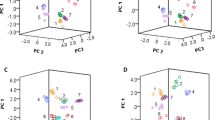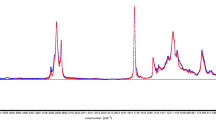Abstract
n-Alkanes of 15 samples of acorn oil from Quercus ilex and Quercus suber have been analysed by gas chromatography. Oil was extracted in a Soxhlet glass apparatus using petroleum ether as solvent. The unsaponifiable matter was fractionated by high-performance liquid chromatography. Then, the analysis was performed on a capillary DB-5MS column (30 m × 0.25 mm i.d., 0.25 μm film thickness), with hydrogen as carrier gas and using a flame ionization detector. Eicosane was used as internal standard for quantification of individual n-alkanes. Gas chromatography-mass spectrometry (GC-MS) analysis in full scan mode was used for their identification. Ten compounds have been identified in these samples: heneicosane, docosane, tricosane, tetracosane, pentacosane, hexacosane, heptacosane, octacosane, nonacosane and triacontane. By using these compounds as chemical descriptors, pattern recognition techniques, such as principal component analysis and linear discriminant analysis, were applied to find out a suitable classification model and differentiate between Q. ilex and Q. suber genuses. The results showed that these compounds allowed the differentiation of the two genuses with a complete classification.




Similar content being viewed by others
References
Coomans D, Massart DL, Kaufman L (1979) Optimization by statistical linear discriminant analysis in analytical chemistry. Anal Chim Acta 112:97–122
De Muth JE (1999) Basic statistic and pharmaceutical statistical applications, 1st edn. Chapman and Hall/CRC, New York
Gamero-Pasadas A, Viera-Alcalde I, Rios JJ, Graciani Constante E, Vicario IM, León-Camacho M (2006) Characterization and quantification of the hydrocarbons fraction of the subcutaneous fresh fat of Iberian pig by off-line combination of high performance liquid chromatography and gas chromatography. J Chrom A 1123:82–91
Gardiner, W.P.(Ed).1997. Statistical analysis methods for chemistry, Royal Society of Chemistry. Cambridge. pp. 313–328.
Guinda A, Lanzón A, Albi T (1996) Differences in hydrocarbons of virgin olive oils obtained from several olive varieties. J Agric Food Chem 44:1723–1726
Harwood,J.L., R. Aparicio, R. (Eds.). 2013. Handbook of Olive Oil: Analysis and Properties, Springer, New York, pp 163–218
http://www.pherobase.com/database/kovats/kovats-index.php. 2012.
International Union of Pure and Applied Chemistry (IUPAC) (1987) Method 1122. Determination of oil content (extraction method). In: Paquot C, Haufenne A (eds) Standard methods for the analysis of oils, fats and derivatives, 7th edn. Blackwell Scientific Publications, Oxford, pp 14–16
Jolliffe IT (2002) Principal components analysis, 2nd edn. Springer, New York
Lanzón A, Albi T, Cert A, Gracián J (1994) The hydrocarbon fraction of virgin olive oil and changes resulting from refining. JAOCS 71:285–292
Nolan JV, Leng RA, Demeyer DI (eds) (1989) The roles of protozoa and fungi in ruminant digestion. Pernanbul Books, New South Whales, pp 153–167
Silva SP, Sabino MA, Fernandes EM, Correlo VM, Boesel LF, Reis RL (2005) Cork: properties, capabilities and applications. Int Mater Rev 50:345–365
Soto E, Hoz L, Ordonez JA, Hierro E, Herranz B, Lopez-Bote C, Cambero MI (2008) Impact of feeding and rearing systems of Iberian pigs on volatile profile and sensory characteristics of dry-cured loin. Meat Sci 79:666–676
StatSoft Inc. 1995. Statistica 5.5 for Windows Computer Program Manual, Tulsa, OK. StatSoft, Inc., 1995, 2300 East 14th Street, Tulsa, OK 74104
Toumi L, Lumaret R (2001) Allozyme characterisation of four Mediterranean evergreen oak species. Biochem Syst Ecol 29:799–817
Waghorn GC (1990) Effect of condensed tannins on protein digestion and nutritive value of fresh herbage. Hoc Aust Soc Anim Prod 18:412–415
Webster L, Simpson P, Shanks AM, Moffat CF (2000) The authentication of olive oil on the basis of hydrocarbon concentration and composition. Analyst 125:97–104
Acknowledgments
The authors are grateful to the Higher Education and Scientific Research Ministry from Republic of Tunisia. This study was supported by project P09-AGR-04789.
Conflict of Interest
Manuel León-Camacho declares that he has no conflict of interest. This article does not contain any studies with human or animal subjects.
Author information
Authors and Affiliations
Corresponding author
Rights and permissions
About this article
Cite this article
Rabhi, F., Narváez-Rivas, M., Boukhchina, S. et al. Authentication of Quercus Species According to Their n-Alkanes Profile by Off-Line Combination of High-Performance Liquid Chromatography and Gas Chromatography. Food Anal. Methods 8, 1710–1717 (2015). https://doi.org/10.1007/s12161-014-0051-0
Received:
Accepted:
Published:
Issue Date:
DOI: https://doi.org/10.1007/s12161-014-0051-0




